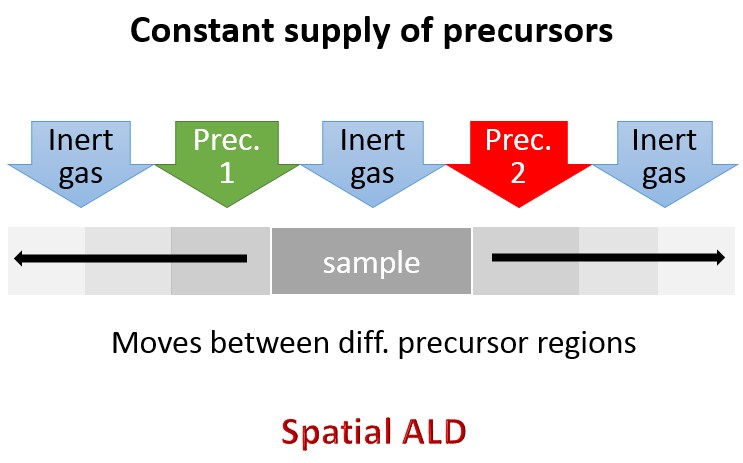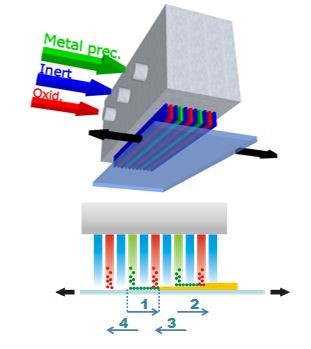Atmospheric pressure Spatial Atomic Layer Deposition (AP-SALD)
AP-SALD is a rather recent alternative approach to ALD that is faster (up to two orders of magnitude) and less expensive (since it can be easily implemented at atmospheric pressure) than ALD. This opens new fields of industrial applications for flexible and large substrates (OLEDs, flat displays, photovoltaic cells, etc).
In SALD, the precursors are dosed continuously in different locations (separation of precursors in space), thus eliminating the need for the purge steps of conventional ALD (where precursors are separated in time, Figure 1). This results in much faster deposition rates than conventional ALD (up to two orders of magnitude, reaching nm/s). In addition, SALD offers plenty of flexibility in terms of design and is fully compatible with high throughput processing methods such as roll-to-roll. Finally, because it can be implemented easily at atmospheric pressure, it can be readily scalable as well. As a result, SALD is receiving increasing interest and attention over the last years since it has the potential to become a widespread laboratory and industrial deposition method for multiple applications including electronics, optoelectronics, textiles, paper, etc.
![[legende-image]1383921695955[/legende-image]](https://harvestore.eu/wp-content/uploads/2020/03/tald-pic.jpg)

The Materials and Physical Engineering laboratory in Grenoble (LMGP, a mixed unit between the CNRS and Grenoble INP), partner of Harvestore, if one of the few groups to develop SALD around the world. The approach used is based on a gas injection manifold where the precursor and inert gas are distributed along parallel channels, the close proximity of the substrate ensuring and efficient separation of the precursors, as shown schematically in Figure 2.

The LMGP designs and develops its own systems, and currently has a first prototype that has been working since 2015, while a second one is currently being implemented for large area deposition (tens of cm2). The materials already available are ZnO, Al2O3, Al:ZnO, TiO2, MnO, Cu2O, and SiOx.
The SALD team is currently developing new materials to be applied to the deposition of components for micro harvestorers, and to demonstrate large-area, high –throughput fabrication of such devices.
More information on the research related to SALD in the LMGP can be found in the following links and references below:
http://www.lmgp.grenoble-inp.fr/en/research/spatial-ald
http://www.lmgp.grenoble-inp.fr/en/research/spatial-atomic-layer-deposition
Refs:
- Muñoz-Rojas D, Maindron T, Esteve A, Piallat F, Kools JCS, Decams J. Speeding up the unique assets of atomic layer deposition. Mater Today Chem. 2019;12:96–120.
- Muñoz-Rojas D, Viet Huong Nguyen, Masse de la Huerta C, Jiménez C, Bellet D. Spatial Atomic Layer Deposition. In: Chemical Vapor Deposition for Nanotechnology. Intech open; 2019. OPEN ACCESS : https://www.intechopen.com/books/chemical-vapor-deposition-for-nanotechnology/spatial-atomic-layer-deposition
- Muñoz-Rojas D, MacManus-Driscoll J. Spatial atmospheric atomic layer deposition: a new laboratory and industrial tool for low-cost photovoltaics. Mater Horizons [Internet]. 2014; 1: 314–20.
Article by David Muñoz-Rojas.
